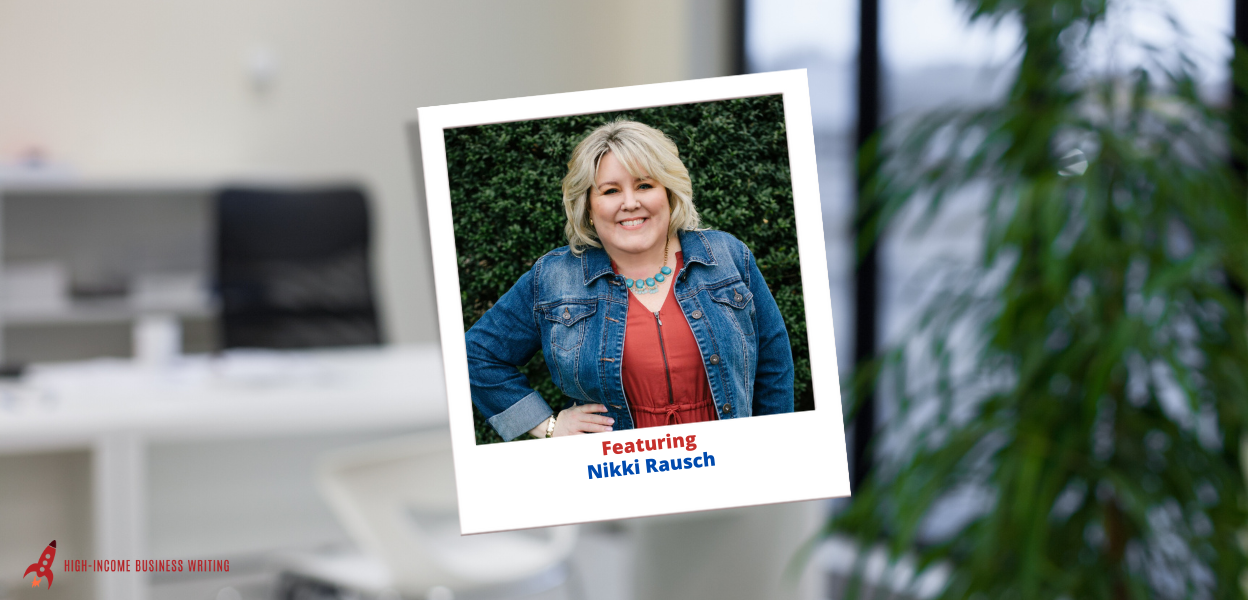2023 has not been a great year for many writers and solo marketing professionals.
And when business is not great, one of the first things we ask ourselves is, Should I change or modify my offerings? Will that make a difference?
It’s a great question to ask yourself. But it’s important that you go about your decision in a more methodical way. So rather than just go with your gut, you’ll make better decisions if you take a more analytical approach to this challenge.
In this episode, we’re addressing this question head on. My guest is Nikki Rausch. Nikki is a selling coach and the CEO of Sales Maven. She has over 25 years of selling experience. And her specialty is helping entrepreneurs, small business owners ?and solo professionals sell successfully and authentically.
This is Nikki’s third appearance in the podcast. She and I are very well aligned in our marketing and sales philosophies, and I love having these important conversations with her. I always walk away with a bit more wisdom and lots of new ideas to think about and implement.
We not only address the issue of service offerings in this conversation, we also get into the importance of lifetime client value, tracking and doubling down on your best marketing strategies, and the biggest mistakes solo professionals make in their sales process when they’re facing a difficult economy.
I hope you enjoy our conversation!
The notes that follow are a very basic, unedited summary of the show. There’s a lot more detail in the audio version. You can listen to the show using the audio player below. Or you can subscribe on Apple Podcasts, Spotify, Stitcher, Google Podcasts, Amazon Music or wherever you listen to podcasts.


High-Income Business Writing with Ed Gandia
#339: How to Identify the Best Services to Offer Your Market in 2024
Key Topics and Bullets:
- Evaluating Existing Offers
- Proactive Client Outreach
- Understanding cognitive bias in business
- Offering Value to Clients
- Avoiding Assumptions and Gather Factual Information
- Sales Maven Studio Launch
- Cognitive Bias and Gratitude
- Mistakes Solo Professionals Make in Selling
- Nurturing Relationships and Staying in Touch
- Analyzing Revenue and Understanding Client Needs
- Advising a client to reach out to past buyers
- The importance of testing offers before investing
Timestamp Overview:
04:46 Nikki– We should be looking at the $200,000 offer and how to grow that because it’s always easier to sell those things when you have momentum, And you obviously have momentum in your business. So I think you gotta look at your offers by category and go, what’s moving the needle in my business? And that’s where you should start to spend some time and energy. And then the next piece of this I’ll add is I think you should look and see who has been your top like, who in the last 10 buyers of that offer, where did they come from? And track back where they came from, because I always say, like, you wanna pour gasoline on the fire. Right? Like, we gotta build that bigger fire if you really wanna scale your business instead of trying to grow these tiny little offers.
10:16 Ed– So now that we know this is what we should be looking at, What, what other analysis or decisions are you making from that?
Nikki– So a couple other things that I’m thinking about are those top tier offers, does it make sense? And when I say top tier, I don’t mean, like, your I mean, like, the ones that are bringing in the most revenue. Like, your top categories of sales. Does it make sense to re-offer those to people who’ve already gone through it? And and I would I would really challenge those of you who are immediately dismissing what I’m saying to take a step back because I do this a lot of clients and they go, Oh, well, somebody already went through the program. They don’t wanna go through it again. Are you sure, or are you making that decision for them? Have you asked? Have you put an offer in front of them?
12:11 Nikki– And I had a client who has a group, like a group program that she puts on, and it’s pretty intensive. It’s a 3 month program for people. We were having conversations about growing her business, and I was like, how many people are doing a repeat of your 3 months? And she’s like, what do you mean repeat? And I was like, well, you know, you’re offering them to come back through. She’s like, I’ve never offered anybody to come back through. I’m like, why not? She’s like, well, they already got the information. Well, did they absorb it 100%? Are you sure that they wouldn’t find value in going back through the program? And she was like It was like a light bulb came on. She was like, I never thought about that.
17:17 Nikki– Has anything changed? Do you have a new offer? Has something in your bio changed? Do you need a new bio? Like, there’s all these things. And, you know, even speaking to case studies, I just had this conversation with a client who I was actually reviewing her case study for, an offer, right, that’s attached to an offer that she’s putting out. And I had made a comment about that one of the kinds of pieces of the case study that I thought needed to be a little bit stronger. And she was like, that’s so interesting you said that because things have changed with this client. They actually have had some updated results come in, and I can go back to them now and get these updated results, which will put a much stronger, like, more compelling, example of a case study to her offer. So maybe the case studies need to be updated too. Right? Like, again, don’t make these assumptions about what a client needs or doesn’t need, make the assumption that they’ll be happy to hear from you. And all you’re doing is just offering to be a resource, offering your and if they don’t need it, okay.
21:28 Nikki– It comes down to okay. So I’ll give you a little analogy and you… I may have even given this on the podcast before. It’s this idea of imagining that you go out and you have a really satisfying meal. And, the wait staff, you know, your waiter comes by and just drops the bill on your table. And you kinda think to yourself like, okay. I guess I’m not gonna even be offered dessert. Now whether you want dessert or not, it feels a little bit like a slight. Like, I feel a little slighted a little bit by or slightly slighted by the fact that they didn’t offer me dessert. Now on the flip side, though, the waiter comes by and they offer you dessert. And you say, oh, thank you so much, but I couldn’t possibly. I’m so satisfied. I’m so full. I’m gonna pass tonight. You know? The waiter doesn’t go back in the kitchen and be like, oh my gosh. You know, this person rejected me. They declined dessert. But from the perspective, you feel good that they at least offered it to you because there’s a little bit of an expectation that, of course, they’re gonna offer you dessert. That’s part of their job, frankly. And your job is to earn somebody’s business. So it is part of your job to touch base and reach back and put a new offer in front of somebody from time to time. And they can decide whether or not they wanna stay on your email list, Whether or not they wanna respond to your reach out, like, they’re adults. They get to decide.
24:49 Ed- I think the important thing here is to think, okay. I’m gonna put myself in their shoes. If I were the marketing director, it’s been 8 months since we did those case studies, and I know that they do quite a bit of business. I bet they’ve had some successes over the past 8 months, but they maybe wanna document. So you reach out and say, that’s the justification. I know it’s been about 8 months or so, and I figured you may have some new stories that you wanna document. Would it make sense for us to reconnect to discuss something like that. I mean, that’s better than not asking, I guess. But it does. What I’m saying is it doesn’t take much to provide a little bit of justification. Justification goes a long way, even if it’s very basic and simple.
Nikki– And it should be basic and simple. You know, I learned this lesson years ago. When I was in my corporate sales job, I had this one account. And the VP of the company, he had this thing. Like, if he saw you in their office, like so I was going out and, you know, working with his salespeople. So a lot of times I was in his office, you know, getting ready to do a ride day with 1 of his sales or whatever. And he would come around and he’d be like, why are you here? And you always had to have a legitimate reason because he didn’t want vendors you know, the manufacturer, which I came from, is the manufacturer side. He didn’t want manufacturer reps just hanging out in their office.
28:29 Nikki– There’s a reason that this is a common phrase when it comes to sales. Repeat business is the easiest business to earn. Like, that gets said all the time in the sales world. Repeat business is the easiest business to earn. And so I often find that sometimes we just not not we, not you and me, but, like, because we know this. But a lot of times people just dismiss This idea of, like, well, they already bought from me.
29:49 Ed– I’m a big proponent. I call it lead nurturing, but it’s really not just lead nurturing. It’s really nurturing all your relationships, especially your… relationships. Right? Past and dormant clients, peers, partners or potential partners, referral sources, anybody. Get them to stay in touch. I’m gonna use the word sequence, but it doesn’t mean you automate it. It just means that you make sure that you’re staying in touch every so many months With just a quick note of, hey, my preferred way is don’t ask something of them every time.I like the 2 to 1 ratio. Two notes of I came across this thought of you. Hope you’re well. 2 of those about 8 weeks apart and then a third one, which is, hey. You know, we did these case studies a few months ago. I’m sure you’ve had some new ones, right? Would you be open to a discussion about doing a couple more? Right. But you’ve made…I love that analogy of the deposits because that’s exactly what you’re doing. You’re making deposits into that rapporte bank account.
34:13 Ed– I wanna shift a little bit here, Nikki, to a related topic, and that is mistakes that you’re seeing solo professionals make In the selling process, let’s just call it, during times that are more challenging than normal, Like, what we’ve been facing over the past year or so. Right? So what are some things you’re noticing that people tend to start doing that are not serving them when the pressure’s on, and what can they do about it?
Nikki– We’ll see if I you know, the first one that came to mind just when you asked me this question. I’m just gonna say it. And if you’re like, that’s not what I wanna talk about, I’m okay with that. But here’s one of them is that when the pressure’s on, the mistake I think people make is they go, Well, I’m just gonna launch a high ticket group program and because that’ll solve all of my problems. And in some cases, it might. But oftentimes, the people that come to me and they’re like, I just want you to help me kinda outline this group program. And I go, Okay. Do you have an audience for the group program? Do you have people that you are pretty sure are gonna wanna sign up for this? Well, no. I’ve never offered a group program before. Well, how’s your email list? What email list? How often do you sell to your email list? What? I don’t. It’s like, You’re gonna have a really hard time filling a group program if you don’t have an audience. Like, that’s not the solution. Often, it’s not the solution.
37:14 Nikki- Test an offer. As a solo offer And see if 1 person will buy it to validate the offer. Because if you put out an offer and it just doesn’t matter when they sign up for it. You can start immediately. You don’t have to wait to fill the program and all these things that go along with it. And you don’t have to update your website and, you know, Make all these changes and put all this money behind a big launch. You can test an offer first and foremost and see, is this a valid offer? Does anybody wanna buy it?
40:00 Nikki– And will they pay for it? Because that’s the other thing. Like, maybe, you know, like, oh, everybody loves this offer because you’ve been giving it away for free. Now you wanna charge for it. We don’t actually know if it’s a viable offer yet. Because if you gave it away for free to a bunch of people and everybody signed up, we need to know will people actually pay money for it and you need to test it before you build a bunch of strategies around it. So, yeah, I love this idea of, like, just test and see what, what’s the response?
42:58 Ed– Is there anything else you’re seeing out there from a selling perspective that when the pressure’s on, people continue to make, you know, the or or making these mistakes. What else comes to mind?
Nikki– A lot of it kinda comes back to they start making assumptions. Oh, people aren’t buying it because they think it’s too expensive. Has anybody said that? And when they say too expensive, what does that mean? Right? Like, there’s a lot of ways to make assumptions. And it’s kind of it’s human nature a little bit to and especially when it comes to sales. As I always say, like, we do 2 things In sales, we assume what the other person thinks about our offer, and then we hallucinate and decide for them whether or not they’ll pay for it. But in actuality, we don’t actually know until we ask questions. So I know I had a client where I had one of the things I advise is to put some pricing on your website. I’m a big proponent of this.
By the way… whenever you’re ready, here are 4 ways I can help you grow your freelance business:
1. Grab a free copy of my book.
It’s called Earn More in Less Time: The Proven Mindset, Strategies and Actions to Prosper as a Freelance Writer. The title says it all. 😉 — Click Here
2. Get my Business-Building Toolkit.
Too many freelancers lack a critical set of business skills that would enable them to earn more in less time doing work they love for better clients. I’ve taught these skills to my coaching clients for years. And now I’ve packaged it in a way that will enable you to start getting results FAST. — Learn More
3. Join my implementation program and be a case study.
I’m putting together a new implementation group this month. If you’re earning $5k+/month (or the part-time equivalent) from your freelance business … and you’d like to grow your income quickly with better clients … just hit reply and put “Case Study” in the subject line.
4. Work with me privately.
If you’re a 6-figure writer who’s trying to earn more in less time, with less stress, I might be able to help you get there faster than you think. Just email me at ed@b2blauncher.com and put “Breakthrough” in the subject line, and I’ll get back to you with more details.






